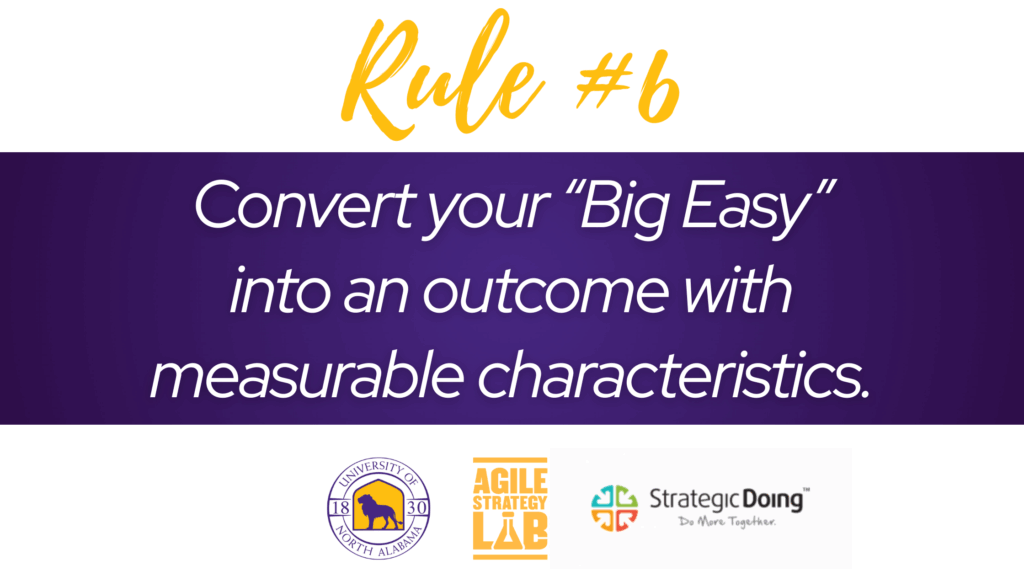Pulling a rabbit out of the hat – Rule/Skill #6
This post is one of a series on the 10 rules/skills and 4 questions of Strategic Doing and agile leadership. Catch up by learning how to find your “Big Easy” here.

With the sixth of the rules/skills, we arrive at an important pivot point, in which team leaders can appear to be pulling a rabbit out of the hat. It’s not magic…but it really can look like it. In this post, I’ll try to de-mystify it…but even after years of watching it happen, I’m still amazed every time.

A more formal description of for this rule is “turning ideas into strategic opportunities with clear outcomes.” When we use this rule, we massage an idea at some length to make sure we understand where we’re headed and that we’re ready to head there.
Why is this skill important?
Very often, once we have an idea that people seem more or less happy with, we start running. It’s as if we fear it can’t stand close examination. Good ideas can survive the process – and examination can also help us improve so-so ideas.
The biggest reason to spend time with your idea is to make sure that everyone is not just on board, but enthusiastic about the idea. Especially when you’re working on addressing a complex challenge, you can be almost certain that there will be setbacks along the way. This step helps you build real commitment to an idea. That’s the rabbit that you’re coaxing out: a shared commitment that will sustain the team over a longer period of time.
A corollary to that is that people don’t commit to slogans, or vague business-speak. They respond when the idea proposed is detailed and feels quite real. The purpose of this rule is to do that work of bringing out details, so that people will sign on whole-heartedly. One of the best routes to figuring those details out is to think about the outcomes: what will success look like?
How to convert your Big Easy into outcomes
Ask people to imagine the successful outcomes of an idea in terms of what they will see, what they will feel, and what will be different for specific people. These are intentionally “right-brained” questions – you want people to respond emotionally. You want people to feel what success will look like (by the way, there’s no truth to the idea that people are either right-brained or left-brained…but different parts of our brain do dominate with different kinds of tasks).
Get comfortable with the silence/discomfort. You’re asking people to do something unfamiliar in tapping into their emotions. It might be quiet for a while. Give an example if needed, but don’t panic if this step takes a while.
Steer people away from metrics, until the outcomes are identified. Most of us are conditioned to go first to numbers when we’re asked about an outcome (blame those SMART goal habits we’ve worked so hard to build – good idea, but not for this). There is no number out there that will make people connect emotionally.

Read the room/table – pay careful attention to people’s responses to one another when they share these ideas. Tip: many introverts shine at this step, but are reluctant to share their ideas – make sure you hear from everyone. You’re looking for the ideas that make participants in the conversation nod, lean in, or otherwise connect with at a deeper level. When people can feel what success will be like, they’re likely committed. Then and only then, attach metrics if needed.
That moment of a group connecting over what success will be like really does feel like a rabbit that just appeared out of a hat. I never get tired of seeing a team reach this point – and I know that their odds of success as a team just went way up.
Action step: if you’re a person that’s uncomfortable in the emotional realm, you might need to practice this one yourself before you lead a group in using it. Take any goal you have – at work or in your personal or civic life – and imagine success. What will you see? What will you feel? Whose life will be different and how? And of course, if you’re looking for help in facilitating a group, the Lab can help you make these moments happen.
Learn more: what you’re asking your team to do in this step is called “prospection.” We’ve heard it called reminiscing in reverse – it’s even been found to create the same endorphins associated with warm nostalgic feelings. This article discusses some of the potential connections between prospection and company strategy and operations.
It’s time to ask Question #3.

Liz shepherds the expansion of the Lab’s programming and partnerships with other universities interested in deploying agile strategy tools. A co-author of Strategic Doing: 10 Skills for Agile Leadership, she also focuses on the development and growth of innovation and STEM education ecosystems, new tool development, and teaching Strategic Doing.
